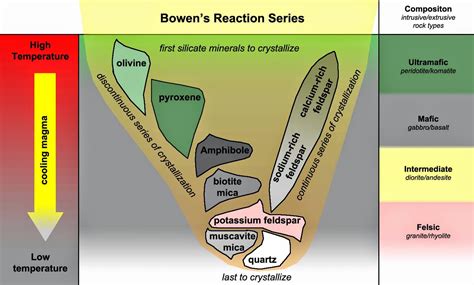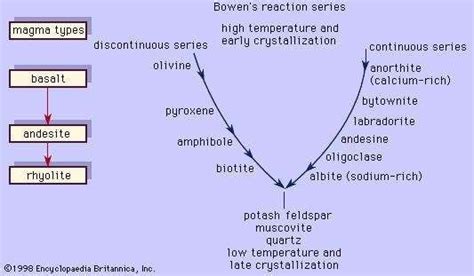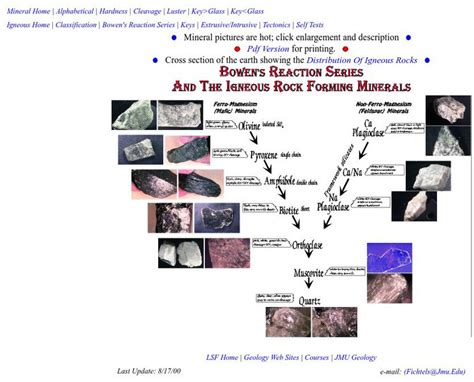Bowen's Reaction Series

Bowen's Reaction Series is a fundamental concept in the field of igneous petrology, which deals with the origin, composition, and evolution of igneous rocks. Developed by Norman L. Bowen in the early 20th century, this series describes the sequence of mineral crystallization from a magma as it cools. The series is crucial in understanding the formation of igneous rocks and their mineralogical composition. Bowen's work laid the foundation for modern petrology, providing a framework for interpreting the complex processes involved in the cooling and solidification of magma.
The series is based on the principle that minerals crystallize from magma in a specific order, depending on their melting points and the composition of the magma. The sequence begins with the crystallization of olivine, followed by pyroxene, amphibole, and biotite, and finally, the crystallization of quartz and feldspar. This order is not random but is determined by the chemical composition of the magma and the temperature and pressure conditions under which it cools. Understanding Bowen's Reaction Series is essential for interpreting the petrological history of igneous rocks and for reconstructing the conditions under which they formed.
Key Points
- Bowen's Reaction Series describes the sequence of mineral crystallization from magma as it cools.
- The series begins with the crystallization of olivine and ends with the crystallization of quartz and feldspar.
- The order of crystallization is determined by the chemical composition of the magma and the conditions under which it cools.
- Understanding Bowen's Reaction Series is crucial for interpreting the petrological history of igneous rocks.
- The series provides a framework for reconstructing the conditions under which igneous rocks formed.
Mineral Crystallization Sequence

The mineral crystallization sequence in Bowen’s Reaction Series can be divided into two main branches: the discontinuous branch and the continuous branch. The discontinuous branch involves the crystallization of minerals such as olivine, pyroxene, amphibole, and biotite, which have distinct melting points and crystallize separately. In contrast, the continuous branch involves the crystallization of plagioclase feldspar, which exhibits a range of compositions and crystallizes continuously as the magma cools.
The discontinuous branch is characterized by a series of reaction points, where the crystallizing mineral reacts with the remaining magma to produce a new mineral. For example, the reaction of olivine with the magma produces pyroxene, which in turn reacts with the magma to produce amphibole. This sequence of reactions continues until the magma has cooled sufficiently for the crystallization of quartz and feldspar. The continuous branch, on the other hand, involves the continuous crystallization of plagioclase feldspar, with the composition of the feldspar changing as the magma cools.
Discontinuous Branch
The discontinuous branch of Bowen’s Reaction Series is characterized by the crystallization of minerals with distinct melting points. The sequence begins with the crystallization of olivine, which has a high melting point and is one of the first minerals to crystallize from the magma. As the magma cools, the olivine reacts with the remaining magma to produce pyroxene, which has a slightly lower melting point. The pyroxene, in turn, reacts with the magma to produce amphibole, which has an even lower melting point.
| Mineral | Melting Point (°C) |
|---|---|
| Olivine | 1890 |
| Pyroxene | 1550 |
| Amphibole | 1000 |
| Biotite | 900 |

Continuous Branch
The continuous branch of Bowen’s Reaction Series involves the crystallization of plagioclase feldspar, which exhibits a range of compositions. As the magma cools, the composition of the feldspar changes, with the calcium content decreasing and the sodium content increasing. This continuous change in composition is reflected in the mineralogy of the resulting igneous rock, with the feldspar grains exhibiting a range of compositions.
The continuous branch is characterized by a series of solid solutions, where the feldspar crystals exhibit a range of compositions. The solid solutions are stable over a range of temperatures and pressures, allowing the feldspar to crystallize continuously as the magma cools. The resulting igneous rock exhibits a range of feldspar compositions, reflecting the continuous change in composition during crystallization.
Applications of Bowen’s Reaction Series

Bowen’s Reaction Series has numerous applications in the field of igneous petrology. By understanding the sequence of mineral crystallization, petrologists can reconstruct the conditions under which an igneous rock formed, including the temperature and pressure of the magma. This information is essential for interpreting the petrological history of igneous rocks and for understanding the processes involved in their formation.
The series is also useful for predicting the mineral composition of igneous rocks. By analyzing the chemical composition of the magma and the conditions under which it cools, petrologists can predict the sequence of mineral crystallization and the resulting mineral composition of the igneous rock. This information is valuable for a range of applications, including the exploration for economic deposits of minerals and the understanding of geological processes.
What is Bowen's Reaction Series?
+Bowen's Reaction Series is a fundamental concept in igneous petrology that describes the sequence of mineral crystallization from magma as it cools.
What are the two main branches of Bowen's Reaction Series?
+The two main branches of Bowen's Reaction Series are the discontinuous branch and the continuous branch.
What is the significance of Bowen's Reaction Series in igneous petrology?
+Bowen's Reaction Series provides a framework for understanding the petrological history of igneous rocks and for reconstructing the conditions under which they formed.
In conclusion, Bowen’s Reaction Series is a fundamental concept in igneous petrology that describes the sequence of mineral crystallization from magma as it cools. The series is divided into two main branches: the discontinuous branch and the continuous branch. Understanding the series is essential for interpreting the petrological history of igneous rocks and for reconstructing the conditions under which they formed. The series has numerous applications in the field of igneous petrology, including the prediction of mineral composition and the understanding of geological processes.



